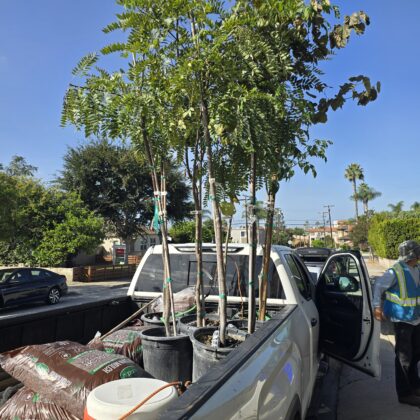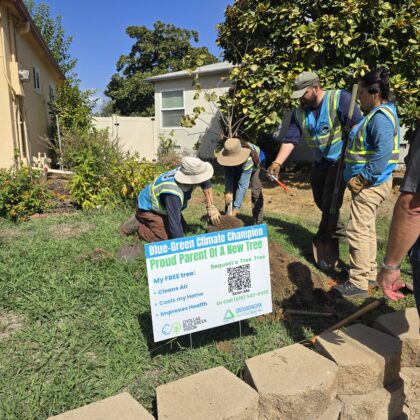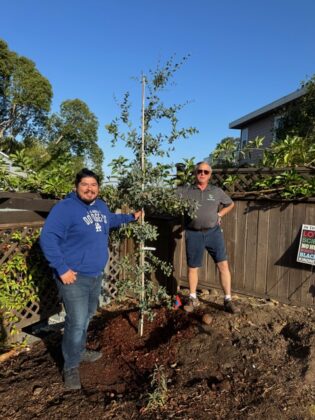
Trees are community resilience superheroes. They provide shade, absorb stormwater, clean the air, provide habitats for native species, and improve mental health. While the answer to many of our environmental challenges is to plant more trees, the logistics, especially in urban neighborhoods, are a lot more complicated. We need places to plant them and people to care for them to realize their full environmental, health, and economic potential.
While Groundwork San Diego Chollas Creek (GWSD) has more than a decade of experience working hand-in-hand with residents to restore and revitalize the Chollas Creek watershed, a devastating flash flood in January 2024 has added a new sense of urgency to addressing the increasingly costly and dangerous flooding conditions.
As the neighborhoods most impacted by this flooding recover and rebuild, GWSD is implementing comprehensive nature-based solutions into the reconstruction effort to reduce the potential impact of future flooding events. Integrating urban forestry into their solutions toolkit was a natural progression, but something entirely new for the organization. Over the past year, they have built their urban forestry program from the ground up, finding their unique niche, expanding their community, and learning important lessons about the importance of resident leadership along the way. Today, they are well on their way to becoming an urban forestry powerhouse, demonstrating the ability of trees to shape communities and the power of communities to shape the future.
BUILDING NEW PARTNERSHIPS THROUGH URBAN FORESTRY
GWSD is not the first organization to step into the urban forestry space in the Watershed. With several tree planting organizations already well established, GWSD was originally hesitant to step into a saturated field. Through dozens of conversations with partners, they learned that while there was no shortage of trees to plant, identifying suitable planting sites was a big barrier to scale. With extensive community engagement experience, grassroots connections, and relationships with residents, GWSD found its unique niche in the sector.

In 2024, GWSD launched a Resident Empowerment Leadership Training program to support Chollas Creek residents in advocating for solutions to their neighborhood’s most pressing challenges. A big part of the training curriculum focuses on guiding the Leaders through outreach and engagement tactics to collect feedback from neighbors and ensure community priorities are reflected in GWSD’s efforts. Because of its Resident Training program, GWSD knows residents personally and understands their concerns, putting them in a position to collaborate with existing urban forestry organizations and integrate community priorities into tree planning across the city. GWSD fills an important gap in the urban forestry landscape in San Diego, connecting the trees that need planting with residents who are passionate and have yard space to plant them.
To support the broad coaltion of tree planting partners across the Watershed, GWSD and its Resident Leaders have been knocking on doors, posting lawn signs, tabling at community events, and attending community planning group meetings to educate the community about the importance of trees in water management and share opportunities for residents to receive trees to plant on their property. Many of the community members GWSD talks to are enthusiastic about trees and excited to join in the tree planting efforts, whether through volunteering, stewardship, or offering up space on their property for planting. GWSD has also hired local companies to plant trees in their neighborhoods, building a sense of environmental responsibility and giving trees a better chance for long-term survival.
TREES AS A GATEWAY TO RESILIENCE PLANNING

Not only is community engagement important for urban forestry efforts, but urban forestry efforts are also serving as a gateway to bring more residents into the resilience conversation in San Diego. Trees are charismatic – most people have some personal connection to them and can understand the benefits they bring to their communities. Through community outreach and the Resident Leaders program, GWSD has capitalized on the general interest in and passion about trees to engage community members in more complicated watershed discussions. Trees are a digestible entry point for residents to understand GWSD’s overall work and contribute to decision-making about effective flood resilience solutions.
looking ahead
GWSD is well on the way to establishing a robust, lasting, community-centered role in urban forestry. They have already planted 130 trees in the first year of their project, 60 of which were planted just in March 2025! GWSD has also been working more closely with the City to find suitable places to plant street trees in areas with little tree canopy coverage, including 35 trees along Ocean Street (a City property). As their partnership strengthens, GWSD hopes to work with the City to site and plant more yard trees in priority neighborhoods.
GWSD’s urban forestry program complements their community engagement efforts, connecting trees to people and ensuring they are planted in the areas that need them the most. They have shown that community input helps create more successful urban forestry programs and that trees make for impactful community engagement tools.
To learn more about their urban forestry efforts, visit Groundwork San Diego.
